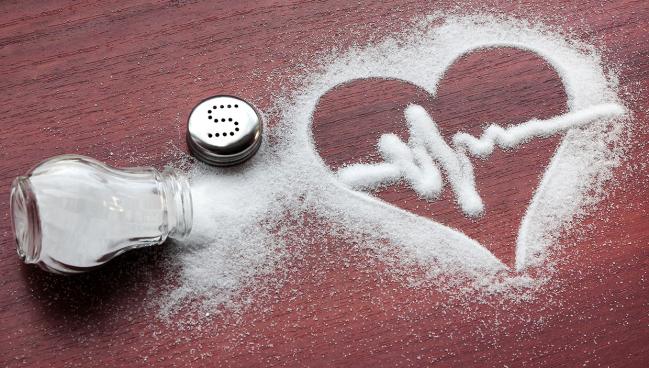Dietary Salt Linked to AF Risk in Patients With Vascular Disease or Diabetes
The analysis of two large trials suggests an association, but falls short of advocating sodium reduction to prevent AF.

Patients at high risk for cardiovascular disease who consume a diet high in sodium may be more likely to develop atrial fibrillation (AF), according to an analysis of patients that combines two large RCTs.
Based on a fasting morning urine intake, the investigators found a J-shaped association between daily sodium levels of 6 g or higher and incident AF over a 4.6-year follow-up period, with a 10% increase in risk for each 1 mg per day above that threshold (HR 1.10; 95%CI 1.03-1.18).
Speaking with TCTMD, lead author Linda S. Johnson, MD, PhD (Lund University, Malmö, Sweden), noted that since this is one of the first large-scale studies on sodium intake and AF, there is much still to learn. “Patients who consume a lot of sodium seem to have higher risk, but based on this study, we wouldn't recommend that anyone reduce their salt intake to reduce atrial fibrillation risk,” she said.
The metabolic connection between high sodium and heightened AF risk is unclear and can’t be addressed by the study, Johnson added. However, most of the patients included in the two RCTs in her study—ONTARGET and TRANSCEND—had hypertension, a potentially modifiable risk factor for AF, and some research has shown lowering sodium can lead to lower BP, at least in some populations
Commenting for TCTMD, Luigi Di Biase, MD, PhD (Albert Einstein College of Medicine at Montefiore Hospital, Bronx, NY), urged caution in interpreting the results, noting that it would be a “false syllogism” to conclude that sodium intake on its own is responsible for AF occurrence.
“What we know is that yes, sodium intake when excessive increases the risk for increasing blood pressure, but [at the same time] patients with diabetes and vascular disease also have a greater disposition for, or risk for, atrial fibrillation,” he said.
The study was published today in JAMA Network Open.
Low and Moderate Salt Intake Not a Problem
Johnson and colleagues included 27,391 people (mean age 66.3 years; 29.5% female) from ONTARGET and TRANSCEND. Both trials consisted of individuals at high risk for cardiovascular events, which was defined as being at least 55 years of age with either established CVD (CAD, PAD, or previous stroke or TIA) or high-risk diabetes with end-organ damage. ONTARGET compared the ACE inhibitor ramipril with the ARB telmisartan, or with a combination of the ACE and the ARB, while TRANSCEND compared telmisartan and placebo. In both studies, incident AF was a prespecified secondary objective.
The mean estimated sodium intake was 4.8 g/day (4.9 g/day in men and 4.4 g/day in women). Approximately 5,200 patients, or just under 20% of the study population, fell into the highest range of sodium intake (6.0-8.0 g/day or higher).
At a mean follow-up of 4.6 years, the rate of incident AF was 5.7%.
While daily sodium intake of < 2 g/day was not associated with an increase in AF, higher intakes were: patients with a daily intake of 8 g or higher had a greater risk than those with a daily intake of 4 to 5.99 g (HR 1.32; 95%CI 1.01-1.74).
Few in the study were on the higher ends of sodium intake, so the increased incidence of AF was limited to a small minority of patients. Nearly 70% of study participants had estimated daily sodium intake of 3 g to 5.99 g and no associated increased risk.
When the investigators analyzed only patients with hypertension, the association between sodium intake and AF mirrored that of the overall population. No evidence of an independent association between sodium intake and AF was observed in individuals without hypertension.
Additionally, patients at the lowest end of daily sodium intake (< 3 g) were not less likely to develop AF compared with those with moderate intake levels (3-5 g) regardless of whether or not they had hypertension.
Exploring the Issue Further
According to Johnson and colleagues, the findings warrant further research, potentially in RCTs “testing effects of both high and low vs moderate sodium intakes with the use of intermediate biomarkers of AF risk and ideally long-term trials of new AF in patients at high risk.”
To TCTMD, Johnson said clarifying the association is important given that AF risk factors are poorly understood.
“Only about 50 to 60 percent of the population risk is generally explained by the standard risk factors that we know,” she said. “There are a lot of cases that happen in the population that are unexplained.” A growing understanding of blood and imaging biomarkers for prediction is helping, Johnson added, but the sodium intake could be another clue, at least in some individuals.
“We need to better understand all the risk factors and salt is ubiquitous. We all eat salt; it’s implicated in cardiovascular disease, and it’s modifiable,” she noted.
Di Biase agreed that more research is needed to shed more light on the correlation observed in the study, noting that the two RCTs carefully followed patients who can’t be generalized to real-world populations.
Given the known increased risk of AF in patients who are already at high risk of CVD, it is worth at least pursuing whether a diet that includes excessive salt intake results in earlier AF presentation or “whether it comes anyway at some point in life,” he added.
L.A. McKeown is a Senior Medical Journalist for TCTMD, the Section Editor of CV Team Forum, and Senior Medical…
Read Full BioSources
Johnson LS, Mente A, Joseph P, et al. Sodium intake and incident atrial fibrillation in individuals with vascular disease. JAMA Network Open. 2024;7(7):e2421589.
Disclosures
- ONTARGET and TRANSCEND were funded by Boehringer Ingelheim.
- Johnson reports receiving personal fees from MEDICALgorithmics outside the submitted work.
- Di Biase reports no relevant conflicts of interest.






Comments